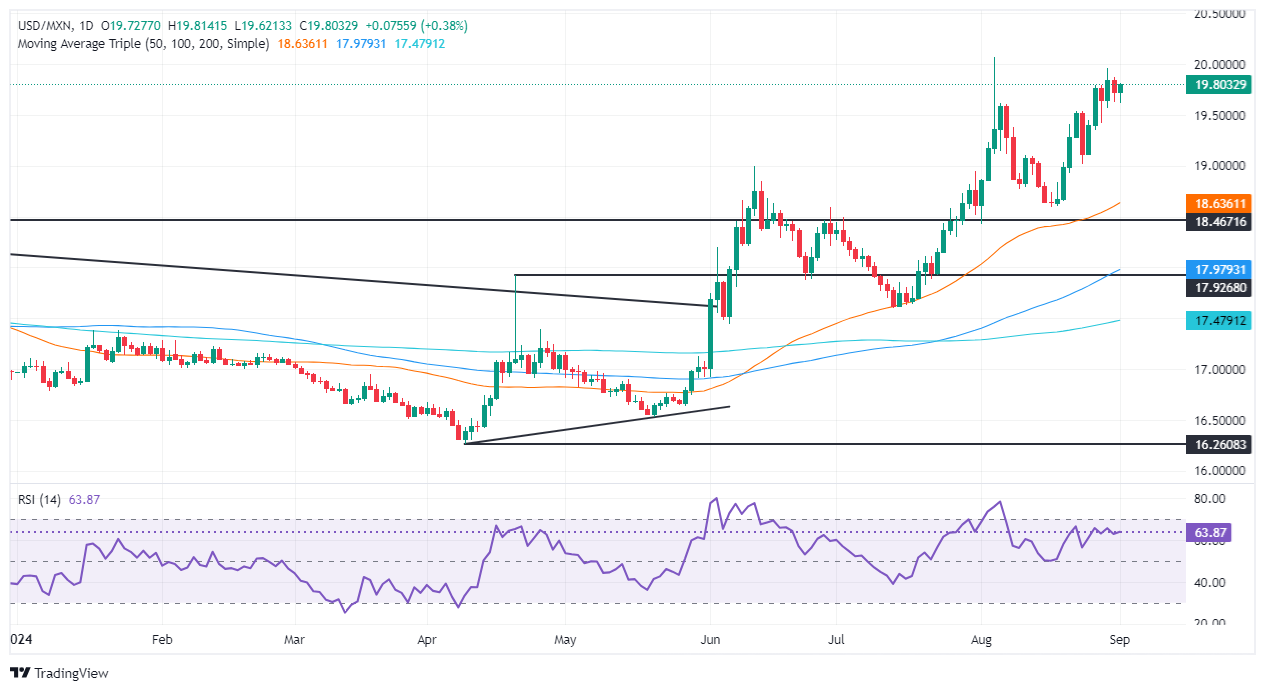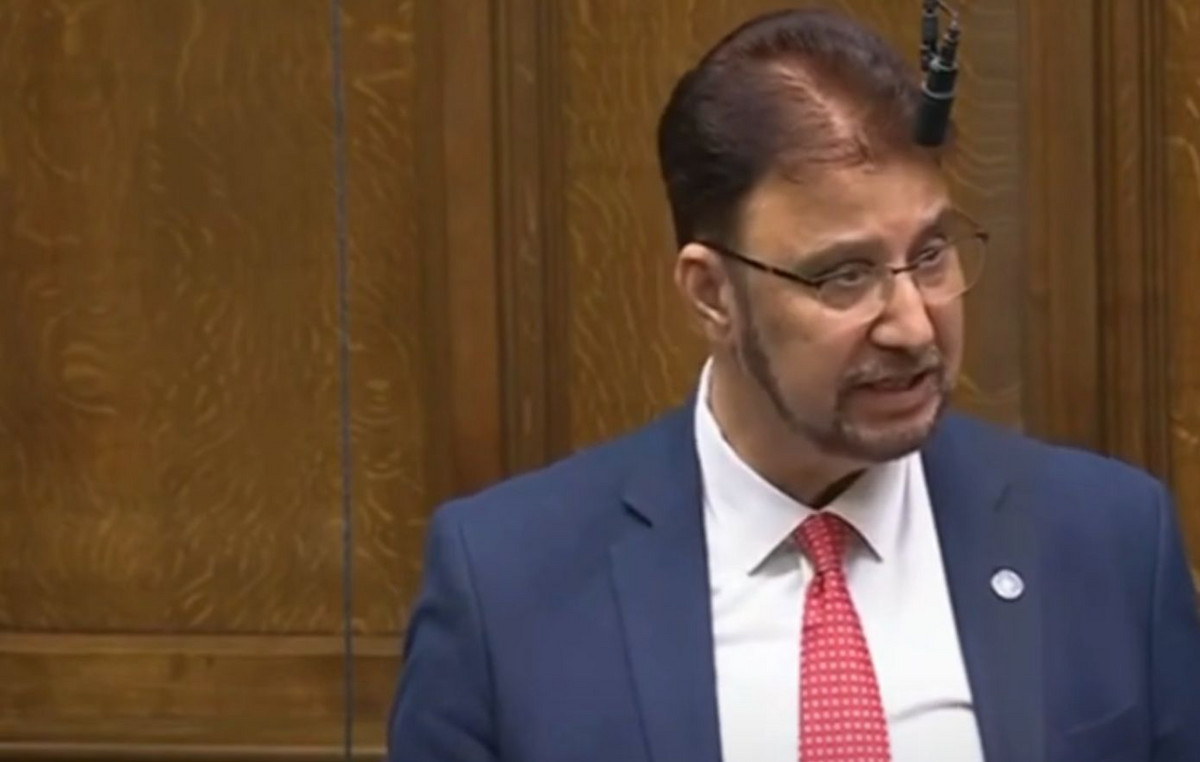- Mexican Peso weakens while USD/MXN rises on concerns about judicial reform following the convening of the new Congress.
- Mexico’s business confidence improves slightly in August, while manufacturing PMI hits a two-year low, indicating sectoral challenges.
- S&P Global cites weak sales, competition from China and road insecurity as key issues for Mexican manufacturers.
The Mexican Peso starts September on a lower note, falling more than 0.50% amid renewed fears that judicial reform will be approved during the first week of the new Mexican Congress that took office on September 1. USD/MXN is trading at 19.80 after jumping from a daily low of 19.60.
Mexico’s economic calendar featured business confidence in August, which improved slightly compared to July’s data. Meanwhile, business activity in August, as measured by the S&P Global manufacturing PMI, fell to its lowest level in two years, the agency revealed.
Pollyanna De Lima, Associate Director of Economics at S&P Global Market Intelligence, commented: “August proved to be another difficult month for Mexican manufacturers, with companies cutting production, employment and inventories due to subdued sales in both domestic and international markets. Total order book volumes fell to the most in two years, which bodes poorly for the near-term production outlook.”
De Lima added that companies were concerned about “intense competition from China and insecurity on the roads.”
At the same time, Mexican business confidence improved, driven by a slight improvement in investment propensity, the National Institute of Statistics, Geography and Informatics (INEGI) revealed.
Across the border, Wall Street remains closed in observance of the Labor Day holiday. Activities will resume on Tuesday, although traders are keeping an eye on the release of employment data on Friday. Nonfarm payrolls (NFP) for August are expected to exceed July’s data.
Meanwhile, the latest inflation report from the US Bureau of Economic Analysis (BEA) revealed that the core Personal Consumption Expenditure (PCE) Price Index, the Fed’s preferred inflation gauge, remained unchanged at around 2.5% year-on-year.
Daily Market Movers Roundup: Mexican Peso on the Defensive Amid Political Turmoil
- Business confidence improved to 53.2 from 53, expanding for the third consecutive month but still below the peak of 54.4 reached in January.
- The S&P Global manufacturing PMI contracted for the second consecutive month, from 49.6 to 48.5, suggesting that Mexico’s economic slowdown is deeper than expected.
- Most banks expect the Bank of Mexico (Banxico) to cut rates by at least 50 basis points (bps) for the remainder of 2024. This would put pressure on the Mexican currency, which has already depreciated 15.38% year-to-date (YTD).
- USD/MXN rally extends on fears of judicial reform approval, prompting flight to safety in the US Dollar.
- In that regard, a judge granted a stay over the weekend to prevent debate on the proposal. The initiative has sparked a strike in the judicial sector, strained relations with the United States and shaken local markets amid widespread doubts it generates.
- Mexican President Andrés Manuel López Obrador’s decision to pause relations with the US and Canadian ambassadors this week will continue to weigh on the Mexican peso.
- US nonfarm payrolls in August are expected to rise to 163,000 from 114,000, while the unemployment rate is forecast to fall to 4.2% from 4.3%.
- Data from the Chicago Board of Trade (CBOT) suggest the Fed will cut at least 96.5 basis points (bps) based on the December 2024 federal funds rate futures contract.
Technical Outlook: Mexican Peso Weakens as USD/MXN Rises Above 19.70
The bullish trend in the USD/MXN remains, with the pair consolidating within the 19.50-20.00 range on the first trading day of September. Momentum is showing further upside as the Relative Strength Index (RSI) is bullish and remained flat after being tilted lower.
If USD/MXN buyers break above the 20.00 figure, there are plenty of additional targets on the upside. The next resistance would be the yearly high at 20.22, followed by the September 28, 2022 daily high at 20.57. If those two levels give way, the next target would be the August 2, 2022 high at 20.82, ahead of 21.00.
In case of further USD/MXN weakness, the first support would be 19.50. A break of the latter will expose the August 23 low at 19.02 before giving way to sellers looking to test the 50-day simple moving average (SMA) at 18.62.
Mexican Peso FAQs
The Mexican Peso is the legal currency of Mexico. The MXN is the most traded currency in Latin America and the third most traded currency in the Americas. The Mexican Peso is the first currency in the world to use the $ sign, prior to the later use of the Dollar. The Mexican Peso or MXN is divided into 100 cents.
Banxico is the Bank of Mexico, the country’s central bank. Created in 1925, it provides the national currency, the MXN, and its primary objective is to preserve its value over time. In addition, the Bank of Mexico manages the country’s international reserves, acts as a lender of last resort to the banking sector, and provides economic and financial advice to the government. Banxico uses the tools and techniques of monetary policy to achieve its objective.
When inflation is high, the value of the Mexican Peso (MXN) tends to decrease. This implies an increase in the cost of living for Mexicans, which affects their ability to invest and save. In general, inflation affects the Mexican economy because Mexico imports a significant amount of final consumer products, such as gas, fuel, food, clothing, etc., and a large amount of production inputs. On the other hand, the higher the inflation and debt, the less attractive the country is for investors.
The exchange rate between the USD and the MXN affects imports and exports between the United States and Mexico, potentially affecting demand and trade flows. The price of the Dollar against the Mexican Peso is affected by factors such as monetary policy, interest rates, the consumer price index, economic growth and some geopolitical decisions.
The exchange rate between the USD and the MXN affects imports and exports between the United States and Mexico, potentially affecting demand and trade flows. The price of the Dollar against the Mexican Peso is affected by factors such as monetary policy, interest rates, the consumer price index, economic growth and some geopolitical decisions.
Source: Fx Street
I am Joshua Winder, a senior-level journalist and editor at World Stock Market. I specialize in covering news related to the stock market and economic trends. With more than 8 years of experience in this field, I have become an expert in financial reporting.








